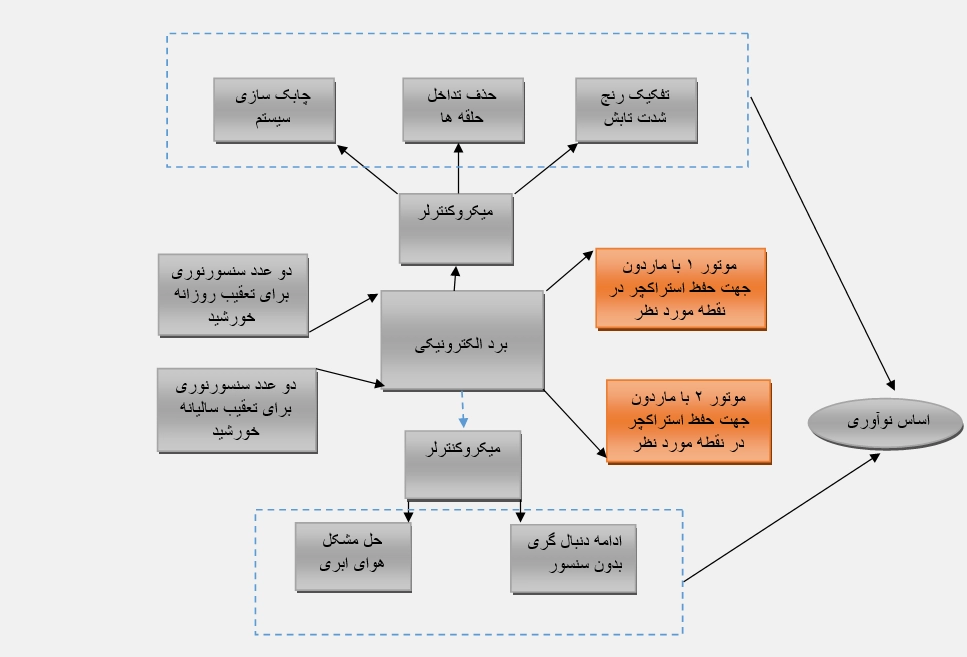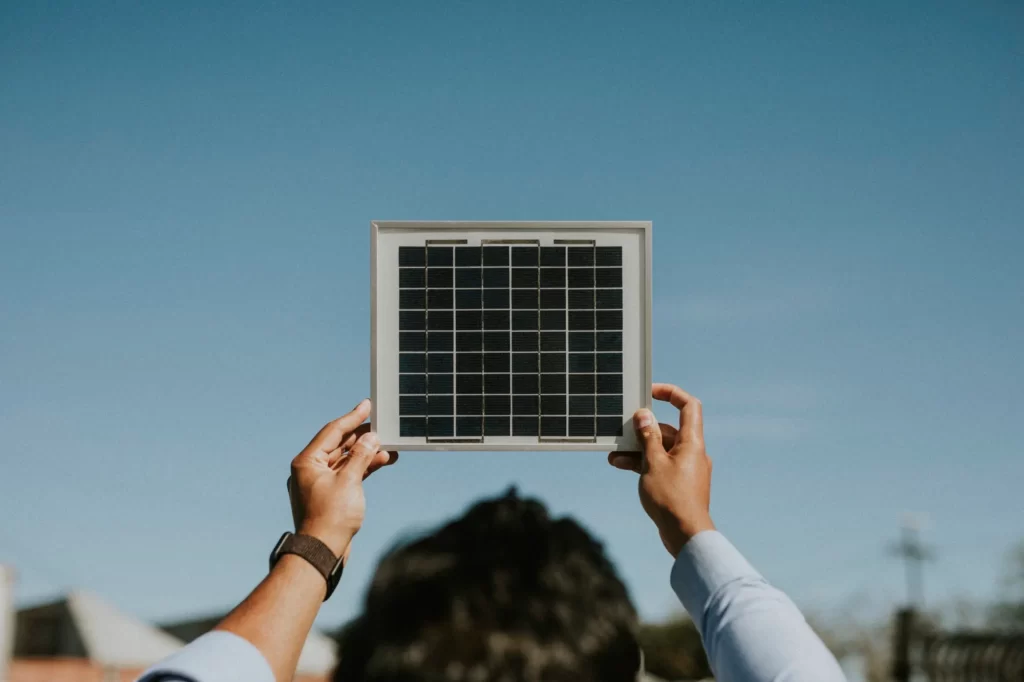Dual-axis solar tracker
Dual-axis solar trackers use advanced technology to precisely adjust the orientation and elevation of solar cells. This allows them to maintain the best angles for capturing sunlight throughout the day. Dual-axis trackers track the sun’s position more accurately, which increases the efficiency of solar energy generation.
Due to the increasing use of new energies, the efficiency of solar panels is one of the influential points in the commercial use of this product. The two-axis solar tracker uses optical sensors to measure the intensity of solar radiation and the direction of radiation and gives commands to the motors to move, and the movement is carried out in two directions: daily (azimuth) and annual (altitude). The designed electronic board receives the command from the sensors and transmits it to the motors so that the motors move based on the coding. In cases such as cloudy weather, loss of sensors, and other errors, an algorithm is designed that takes control and implements the ability to perform tracking with the goal of maximum energy production for the solar panel.
Detailed technical specifications of the dual-axis solar tracker
Radiation intensity range separation
Separation of radiation intensity range (to identify the time period when tracking is performed, morning (evening) or noon, for use in the designed algorithm)
Accuracy in sensor performance
Separation of radiation intensity range (to identify the time period when tracking is performed, morning (evening) or noon, for use in the designed algorithm)
Maximum power absorption
Maximum power absorption based on the designed algorithm in cloudy weather with the solar panel facing the sky (in the case of the sun disappearing, the panel must face the sky to receive maximum power)
Interference of rings
Due to the change in the movement angle on the two axes, there is a need to constantly change the motors, but by adjusting the annual movement angle (altitude) at the beginning of the movement each morning and stabilizing it until the end of the day, the rings are practically independent and do not affect each other.
Cost savings
Determining the next day's starting point based on the previous day's ending point prevents additional movement of the panel to reach the tracking starting point, eliminates the need for a start and end disconnection sensor, and clearly saves costs and makes the system more agile.
Block diagram and components of a solar tracker
The solar tracker uses solar sensors to measure sunlight and angle sensors to determine the position of the sun. The control system adjusts the tracker’s movements with intelligent programming. The mechanical structure is designed with components such as the base and mechanical devices to move the tracker. Solar modules with solar cells convert light into energy. A battery-powered system or clean power system provides energy for use at night or in low-light conditions. The communication unit uses Wi-Fi and other connections to transmit information to other systems or for remote monitoring.

Solar tracker hardware components
Solar trackers (a combination of mechanical and electronic systems) are used to track the movement of the sun in order to optimize sunlight reception and increase the efficiency of solar cells. These devices consist of various hardware components. However, the exact components of each tracker may vary depending on its type and specific application.
Solar trackers consist of mechanical components such as the base and motion devices, solar and angle sensors, a control system with a controller and control electronics, a battery power system, a shader for light management, solar cells as the energy source, and communication and monitoring components such as Wi-Fi and temperature sensors.
Special and distinctive technologies, technological challenges in product development
In the development of solar trackers, specific technologies are used that give the product a distinctive identity and identity. These technologies include artificial intelligence and machine learning, Internet of Things (IoT) communication networks, advanced sensors, data analysis systems, and low energy consumption. However, there are also technological challenges in the development of solar trackers. These challenges include accurate prediction of the sun’s movement, adaptation to different environmental conditions, resistance to weather conditions, security of collected information, and coordination with existing technologies in the field of solar energy.
- Technology for developing solutions based on advanced image processing
- Integrated Circuit Design and Manufacturing Technology
- Technology for designing and manufacturing industrial electronic boards with EMC considerations
- Argon welding and how to bend and laser cut steel sheets
- Achieving a power density of one kilowatt per centimeter
- Achieving harmonic pollution below 3 percent

Solar tracker technical development process
Initially, a simple two-axis tracker that only follows the direction of the sun was designed, and then, through field tests, the flaws were revealed, and the tracking problem arose in cloudy weather. By developing the design algorithm and considering the possibility of uncertainty in the information sent by GPS and the error of the mathematical method, we concluded that an algorithm should be used that makes the best decision by considering possible errors. The recently designed algorithm faces the sky in cloudy weather, and in case of uncertainty, the sensor guides the system to the final state. By developing the system using the developed algorithm, the end sensors were also removed to detect and determine the absence of movement, making the system simpler and more reliable. In the continuation of the development of the system, the interference of the system loops was eliminated.
